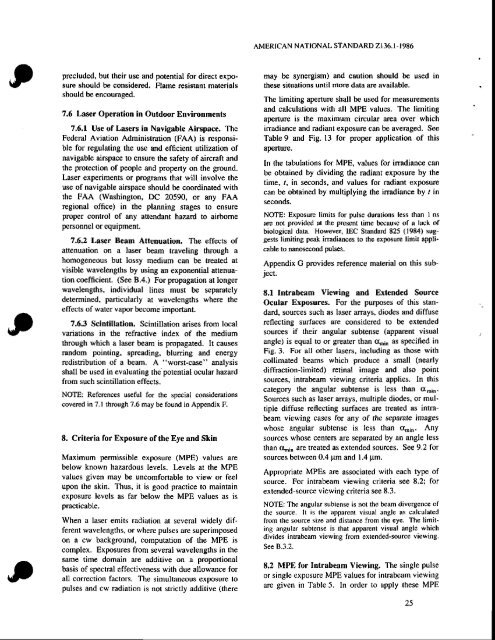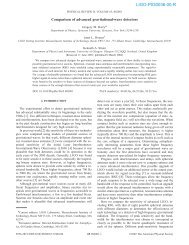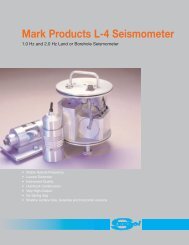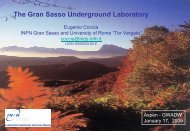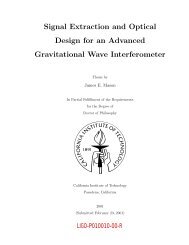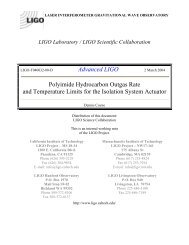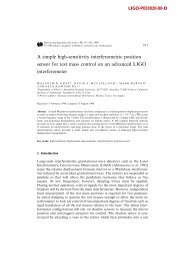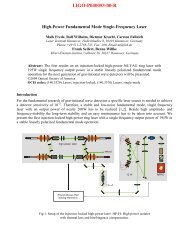for the sqfe use of lqsers - LIGO
for the sqfe use of lqsers - LIGO
for the sqfe use of lqsers - LIGO
Create successful ePaper yourself
Turn your PDF publications into a flip-book with our unique Google optimized e-Paper software.
precluded, but <strong>the</strong>ir <strong>use</strong> and potential <strong>for</strong> direct expo-<br />
$ure should be considercd. Flame resictant materials<br />
should be encouraged.<br />
7.6 Laser Operation in Outdoor Environments<br />
7.6.1 Use <strong>of</strong> Lasers in Navigable Airspace, The<br />
Federal Aviation Administration (FAA) is responsible<br />
<strong>for</strong> regulating <strong>the</strong> <strong>use</strong> and efficient utilization <strong>of</strong><br />
navigable airspace to ensurc <strong>the</strong> safety <strong>of</strong> aircraft and<br />
<strong>the</strong> protection <strong>of</strong> people and propefly on <strong>the</strong> ground.<br />
Laser experiments or programs that will involve <strong>the</strong><br />
<strong>use</strong> <strong>of</strong> navigable airspace should be coordinated with<br />
<strong>the</strong> FAA (Washington, DC 20590, or any FAA<br />
regional <strong>of</strong>fice) in <strong>the</strong> planning stages to ensure<br />
pmper control <strong>of</strong> any attendant hazard to airbome<br />
personnel or equipment.<br />
7.6.2 Laser Beam Attenuation. The effects <strong>of</strong><br />
attenuation on a laser beam traveling through a<br />
homogeneous but lossy medium can be trested at<br />
visible wavelengths by using an exponential attenuation<br />
coefficient. (See B.4.) For propagation at longer<br />
wavelengths, individual lines must be separately<br />
determined, panicularly at wavelengths where <strong>the</strong><br />
effects <strong>of</strong> waier vapor become important.<br />
7.6.3 Scintillation, Scintillation arises from local<br />
variations in <strong>the</strong> refractive index <strong>of</strong> <strong>the</strong> medium<br />
through which a laser beam is propagated. It ca<strong>use</strong>s<br />
random pointing, spreading, blurring and energy<br />
redistribution <strong>of</strong> a beam. A "worst-case" analysis<br />
shall be <strong>use</strong>d in evaluating <strong>the</strong> potential ocular hazard<br />
from such scintillation €ffects.<br />
NOTE: References <strong>use</strong>ful <strong>for</strong> <strong>the</strong> special considerations<br />
covered in 7-l through 7.6 may be found in Appendix F.<br />
8. Criteria <strong>for</strong> Exposure <strong>of</strong><strong>the</strong> Eye and Skin<br />
Maximum prermissibte exposure (MPE) values are<br />
below known hazardous levels. Levels at <strong>the</strong> MPE<br />
values given may be uncomfonable to view or feel<br />
upon <strong>the</strong> skin. Thus, it is good practice to maintain<br />
exposure levels as far below <strong>the</strong> MPE values as is<br />
practicable.<br />
When a laser emits radiation at several widely different<br />
wayelengths, or where pulses are superimposed<br />
on a cw background, computation <strong>of</strong> <strong>the</strong> MPE is<br />
complex. Exposures from several wavelengths in <strong>the</strong><br />
same time domain are additive on a proportional<br />
basis <strong>of</strong> specral effectiveness with due allowance <strong>for</strong><br />
all correction factors. The simultaneous exposure to<br />
pulses and cw radiation is not strictly additive (<strong>the</strong>re<br />
AMERICAN NATIONAL STANDARD 2I36.1-I986<br />
may be synergism) and caution should be <strong>use</strong>d in<br />
<strong>the</strong>se situations until more data arc available.<br />
The limiting aperture shall be <strong>use</strong>d <strong>for</strong> measurements<br />
and calculations with all MPE values. The limiting<br />
aperture is <strong>the</strong> maximum circular area over which<br />
irradiance and radiant exposure can be averaged. See<br />
Table 9 and Fig. 13 <strong>for</strong> proper application <strong>of</strong> this<br />
aPenurc.<br />
In <strong>the</strong> tabulations <strong>for</strong> MPE, values <strong>for</strong> irradiance can<br />
be obtained by dividing <strong>the</strong> radiant exposure by <strong>the</strong><br />
time, t, in seconds, and values <strong>for</strong> radiant exposure<br />
can be obtained by multiplying <strong>the</strong> irradiance by r in<br />
seconds.<br />
NOTE: Exposure limits <strong>for</strong> pulse duralions less than I ns<br />
are Dot provided !1 lhc prescnt time becausc <strong>of</strong> a laqk <strong>of</strong><br />
biological data. However, IEC Srandard 825 (1984) suggests<br />
limiting peak inadianc€s to <strong>the</strong> exposure limit applicable<br />
to nanosecond pulses.<br />
Appendix G provides reference material on this subject.<br />
8.1 Intrabeam Viewing and Extend€d Source<br />
Ocular Exposures. For <strong>the</strong> purposes <strong>of</strong> this standard,<br />
sources such as laser arrays, diodes and diff<strong>use</strong><br />
reflecting surfaces are considered to be extended<br />
sources if <strong>the</strong>ir angular subtense (apparent visual<br />
angle) is equal to or greater than cr,;n as specifled in<br />
Fig.3. For all o<strong>the</strong>r laseni, including as those wilh<br />
collimated beams which produce a small (nearly<br />
diffractionlimited) retinal imag€ and also point<br />
sources, intrabeam viewing criteria applies. In this<br />
category <strong>the</strong> angular subtense is less than o-in.<br />
Sources such as laser arrays, multiple diodes, or multiple<br />
diff<strong>use</strong> reflecting surfaces are treated as in[abeam<br />
viewing cases <strong>for</strong> any <strong>of</strong> <strong>the</strong> separate images<br />
whose angular subtense is less than (Iln6. Any<br />
sources whose centers are separated by an angle less<br />
than ohrin are treated as extended sources. See 9.2 <strong>for</strong><br />
sources between 0.4 pm and L4 Um.<br />
Appropriate MPES are associated with each type <strong>of</strong><br />
source, For intrabeam viewing criteria see 8.2t <strong>for</strong><br />
extended-source viewing criteria see 8.3.<br />
NOTE: The angular subtense is not <strong>the</strong> beam divergence <strong>of</strong><br />
<strong>the</strong> source. It is <strong>the</strong> apparent visual angle as calculated<br />
from <strong>the</strong> source size and distance from <strong>the</strong> eye. The limiting<br />
angular subtense is that apparent visual angle which<br />
divides intrabeam viewing from extended-source viewing.<br />
See B-3-2.<br />
8.2 MPE <strong>for</strong> Inarabeam Viewing. The single pulse<br />
or single exposure MPE values <strong>for</strong> intrabeam viewing<br />
are given in Table 5. ln order to apply <strong>the</strong>se MPE<br />
ZJ


